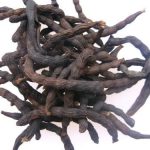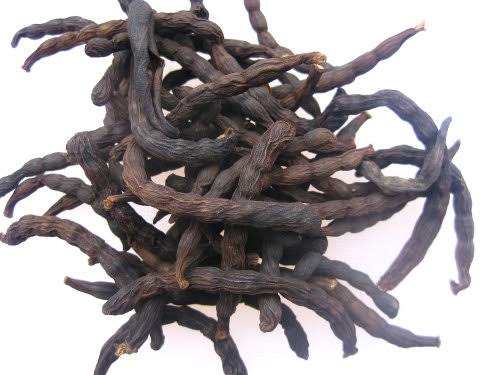Xylopia aethiopica or Negro pepper (synonyms: grains of Selim, Kani pepper, Kili pepper, Uda, Moor pepper, West African pepper tree, Senegal pepper, African guinea pepper, Ethiopian pepper) or À góógè or Kímbáá or Citta mai kwaya (Hausa): A pepper alternative with many medicinal uses
Occurrence and Description of Negro Pepper (Uda)
Xylopia aethiopica is wide spread in tropical Africa, Zambia, Mozambique and Angola. Xylopia is Greek (‘xylon pikron’) for ‘bitter wood’, while aethiopica refers to its Ethiopian origin. Xylopia aethiopica is a slim, tall, evergreen, aromatic tree measuring 15-30 m high and about 60-70 cm in diameter with straight stem, many-branched crown and sometimes buttressed. The bark is grey-brown, smooth or finely vertically fissured and peeling easily. The fruits are small, carpels 7-24, forming dense cluster, twisted bean-like pods, dark brown, cylindrical, 1.5-6 cm long and 4-7 mm thick; the contours of the seeds are visible from outside.
The seeds are black, 5-8 per pod, kidney-shaped seeds of approximately 10 mm length with a yellow papery aril. The hull is aromatic, but not the seed itself. In Nigeria, it is found all over the lowland rain forest and most fringe forest in the Savannah zones of Nigeria. In West Africa, the tree bears flowers twice annually (March-July and October-December), while fruiting occurs in December-March and June-September.
Health benefits of Negro Pepper (Xylopia aethiopica) or Uda
Negro pepper as it is also known has been used as a pepper substitute in Europe and India. X. aethiopica is common in ethno-medicine in West Africa. This is due to its preservative effect; the fruit extract has been shown to be active as antimicrobial agent against gram positive and gram negative bacteria, but has not been shown to be effective against Escherichia coli. Xylopia aethiopica has anti-spirochoectal properties and therefore it may work both as a preventive measure and in the treatment of primary, secondary and tertiary stages of syphilis.
X. aethiopica has been used traditionally for treating rheumatism and arthritis as well as other inflammatory conditions. Numerous studies have confirmed the spice’s anti-inflammatory and antipyretic (fever reducing) properties. Indian scientists have reported anti-arthritic and anti-inflammatory activities of one of the compounds in X. aethiopica called nimbidin. The seeds are mainly used by traditional medicine healers and can also serve as an alternative to pepper.
The plant is used medicinally: as a carminative, cough remedy and as a post-partum (after giving birth to a baby) tonic and lactation aid. Other uses include treatment for stomach ache, bronchitis, biliousness (excess secretion of bile in gallbladder and liver disease) and dysentery.
It has also been reported to be used as a flavour in palm wine or dry gin. Uda has been reported by some authors to be a potent contraceptive (prevent pregnancy) and used by some women for abortions. It is said to promote fertility and also used to cure fibroids.
The bark of X. aethiopica tree when steeped in palm wine is given for attacks of asthma and rheumatism. It is generally agreed that fruits and vegetables have many healthful properties.
There is considerable epidemiological evidence revealing the association between people, who consume a diet rich in fresh fruits and vegetables and a decreased risk of cardiovascular diseases, certain forms of cancer as many other chronic diseases. The constituent of fruits and vegetables that contribute to these protective effects are phytochemicals, vitamins and minerals.
Naturally occurring phytochemicals like flavonoids are potentially anti-allergic, anti-carcinogenic, antiviral and antioxidant agents. Phytochemicals as antioxidants play vital roles in human health.
X. aethiopica has been found to contain some phytochemicals which exhibit a wide range of biological effects as a consequence of their antioxidant properties chemical components of X. aethiopica have been helpful in the avoidance and treatment of cancerous tumors.
Scientists in India, Europe and Japan have found that polysaccharides and limonoids found in X. aethiopica reduce tumours and cancers. Flavonoids represent the most common and widely distributed of plant phenolic compounds found in X.aethiopica.

Credit: Yateso
Flavonoids prevent oxidative cell damage (by eliminating dangerous free radicals), have strong anti-cancer activity and protect against all stages of carcinogenesis (processes of cancer formation).
As antioxidants, flavonoids derived from X. aethiopica possess anti-inflammatory activities. Anonecaine being an alkaloid constituent of X. aethiopica is known to have anti-pyretic effect. Saponins another group of phytochemical constituent of X. aethiopica have wide range of biological properties; they are used to recover homoeostasis, have anti-inflammatory and anti-cancer properties.
These are the thoughts of:
Sa’eed Halilu Bawa
Senior Lecturer (Associate Professor) at University of the West Indies, St. Augustine Campus, Trinidad.
Studied Food and Nutrition Sciences, Dietetics at Kaduna Polytechnic, Nigeria; Warsaw University of Life Sciences, Poland.

























Thanks Sir.